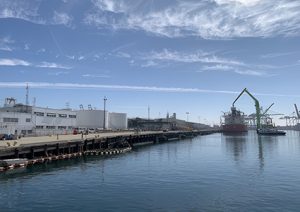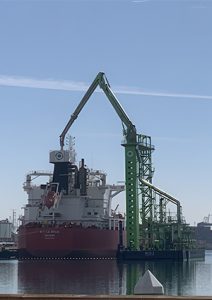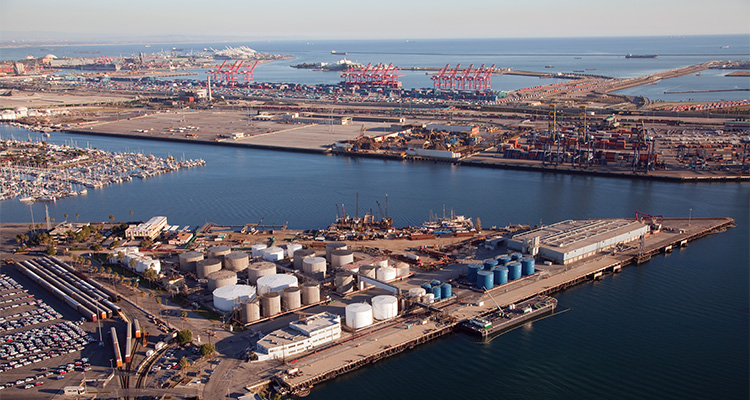A new approach to emissions capture in California is helping Vopak demonstrate its dedication to sustainability
Leading independent tank storage company Vopak has been at the forefront of fundamental transformations for more than 400 years. Now with its partners and customers, Vopak is accelerating the development of infrastructure solutions for hydrogen, ammonia, CO₂, battery energy storage systems, and low-carbon fuels and feedstocks – paving the way to a more sustainable future.
With a total of 78 terminals, Vopak’s extensive tank network helps clients navigate the global flow of supply and demand, create new connections, and embrace opportunities that drive progress. 
Shining the spotlight on Vopak’s US West Coast operations and its two strategically located sea terminals, at the Port of Los Angeles and the Port of Long Beach, Energy, Oil & Gas speaks to Brandon Friend, Site Director, West Coast, Vopak Terminal Los Angeles, Inc. He begins by introducing a new technology that could be a game changer in emissions capture.
The solution has been introduced to address the new California Air Resources Board (CARB) Ocean-Going Vessels At Berth regulation, which aims to reduce emissions from ships docked at California ports and improve public health by decreasing exposure to harmful pollutants. It now requires tankers and several other vessel classes to use a CARB-Approved Emission Control Strategy (CAECS) or shore power when docked at regulated terminals in California, specifically including the ports of Los Angeles and Long Beach for tankers.
Having considered the available solutions that would help them conform to the new regulations, the Vopak team made a bold decision and embarked on a trailblazing project to introduce a barge-based emissions capture system for tankers. “This barge technology is really the first of its kind and we’re excited to see it coming together,” says Brandon. “We partnered with Clean Air Engineering Maritime (CAEM) in 2023 to start on this project, and it’s been a very successful implementation.
“We can’t take the credit for the solution as CAEM developed and purpose-built these barges. They are a pioneering piece of technology that have been designed to safely provide service to tankers.” The barge captures and treats emissions directly from tankers while they are docked, thanks to an innovative system that is positioned directly over the vessel’s exhaust. It captures and treats particulate matter (PM), nitrogen oxides (NOx), and reactive organic gasses.
“We are thrilled to be able to get this technology off the ground and start capturing these emissions to comply with the new regulation,” adds Brandon. “It means we have the ability to service a wider range of tankers that might be calling in Southern California.”
He also identifies another vital element of the solution. “Safety is number one in everything we do. We never take this for granted, and it is absolutely at the forefront of our operations. So, while this barge project serves a very specific and important air quality initiative, safety is paramount, and therefore this barge complies with all the needs of flammable cargoes and emergency situations. We spent considerable time working through the technology, ensuring safeguards and mitigating any potential risks of operation.
“The safety element has been thoroughly vetted through various hazard reviews and by the relevant stakeholders involved, ensuring that incidents are prevented and our stringent safety requirements are maintained.”
Brandon’s enthusiasm for the barge project is evident as he discusses its potential and emphasizes its current unique position in the market. “It doesn’t really exist anywhere else in the world. It’s exciting to be involved with this technology and see the benefits that it could bring to ports. We know that shore power is another potentially viable technology, but we’re championing this barge approach due to the quick time to market and flexibility it provides.”
Sustainable fuels support
While continuing to fully implement the barge technology is a high priority for Vopak’s operations in the West Coast, the company remains focused on servicing its customers, done by supporting local distribution of the critical fuels that it stores in its tanks. “There are three major ways that we’re participating in the fuel economy,” explains Brandon. “One way is with marine fuels, where we provide a bunkering hub. The second way is for road transport fuels with renewable diesel, and the third way is by supplying sustainable aviation fuel (SAF) and conventional jet fuel to local airports. Ensuring these three elements are maintained and supported is key.
“SAF and renewable diesel can be called transitional fuels, as they can drop into the current supply chain and be used while the future infrastructure for fully renewable energy is established. We can handle those fuels straight away and blend them to the right requirements and immediately start reducing the carbon footprint of aviation or road transport. We have a positive outlook on these types of sustainable fuels, and we see opportunities to continue supporting the energy transition.”
 Its dedication to both transitional fuels and the diesel exhaust capture barge reflects Vopak’s commitment to sustainability and innovation in the energy infrastructure sector. This also highlights California’s leading position on sustainability, and Brandon believes that where the state leads, others will follow. “We’re eager to see how that’ll play out,” he confirms. “There’s certainly viability in the barge solution and it’s proved to be quite practical in its application, so we expect to see it rolling out into other ports as well.
Its dedication to both transitional fuels and the diesel exhaust capture barge reflects Vopak’s commitment to sustainability and innovation in the energy infrastructure sector. This also highlights California’s leading position on sustainability, and Brandon believes that where the state leads, others will follow. “We’re eager to see how that’ll play out,” he confirms. “There’s certainly viability in the barge solution and it’s proved to be quite practical in its application, so we expect to see it rolling out into other ports as well.
Community engagement
“California’s environmentally focused culture fits well with our own company culture,” he continues. “Vopak has an Environmental, Social, and Governance strategy with multiple pillars and there is strong synergy with what California is doing in terms of improving air quality and enhancing the lives of people living close by these port areas. We are happy to be involved with this project, and it is exciting to be able to reduce the impact of our operations.”
Having introduced the importance that Vopak places on the local community, Brandon notes that new technologies, such as the diesel exhaust capture barge, have the potential to generate jobs for the local area. “This project and the initiative overall support additional jobs, between the barges being built in the US and the barge operation itself.
“We’re always engaging with our local community as much as we can. We are keen to hire new staff and interns from areas close to the ports where we operate. Vopak has a program called WeConnect, which is in place across all locations. For our part we have a partnership with the YMCA Long Beach Youth Institute, where we annually bring a group of students onsite for a day, give them a tour of the terminal and explain what we do and how our business supports the local economy. We explain what these kinds of jobs are like and how to get started in this industry. It’s important to keep younger folks interested and engage with them early to build the next leaders for the organization.”
As Vopak’s West Coast operations continue to trailblaze for the diesel exhaust capture barge technology, Brandon and his team gain valuable experience, giving them a clear market advantage. Combined with its positive company culture and impressive team spirit, Vopak is positioning itself as the ideal partner to help support a truly sustainable energy future.
